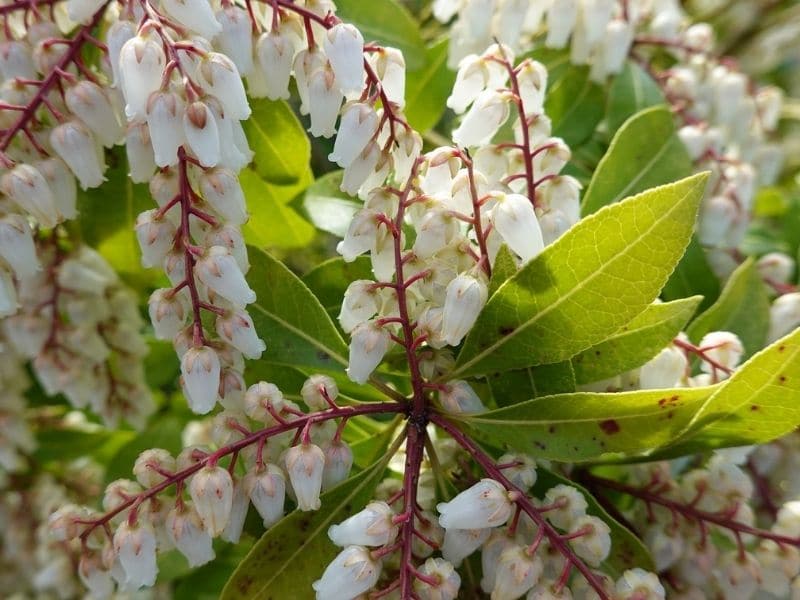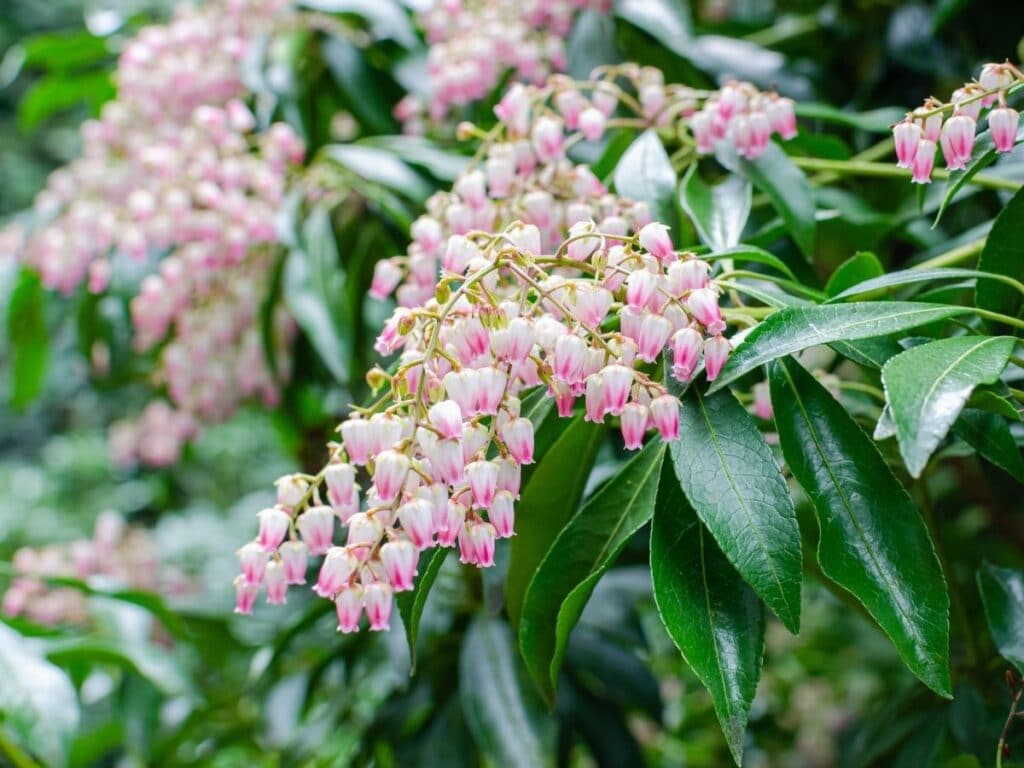Japanese andromeda is a highly ornamental and showy flowering shrub or small tree that has many uses in the garden. With so many different cultivars available, there’s a Japanese pieris for just about anyone.
If there’s one downside to this plant, however, it’s that it has some highly toxic properties. Nevertheless, this is a great plant, so read on to learn all you need to know about how to grow and care for it.
What Is A Japanese Andromeda Shrub?
Japanese andromeda (Pieris japonica), or the Japanese Pieris, or Mountain Fire, as it is also known, is a flowering shrub or small tree of the Ericaceae family.
As their name suggests, these broadleaf evergreens are native to Japan, as well as Taiwan and eastern China where they occur in mountain thickets.
Wild-type plants reach 9 to 13 feet (2.7 to 4 m) tall and wide and have alternately arranged, glossy green leaves of 1.5 to 3.5 inches (4 to 9 cm) long. Young new foliage is often a stunning bronze pink color before maturing.
These slow-growing plants are very popular among gardeners and there are a huge number of different cultivars available.

Pieris Japonica Varieties/Cultivars
There are very many different forms of this plant available to gardeners. Some popular options include:
‘Red Head’ is a fantastic option for gardeners looking for a splash of red color in the landscape. This effect is created by the brilliant red new growth at the ends of branches.
‘Flaming Silver’ is a variegated cultivar that develops silver and green foliage after the red to pink new growth matures. This is a white-flowered cultivar.
‘Little Heath Green’ is a great option for gardeners with limited space. This white-flowering form is compact, growing slowly to about 2 ½ feet (0.75 m).
‘Pink Delight’ is a lovely cultivar that produces pale pink blossoms and green foliage, with bronze new growth. Additionally, Japanese pieris produces clusters of buds in late summer that remain through winter. After the early spring blooms fade, decorative seed pods remain until new buds form.
Japanese Andromeda Flowers
The Japanese Andromeda is a very showy shrub indeed. Depending on the cultivar, these plants produce masses of white to pink, hanging bell-shaped flowers. Blossoming occurs in the late winter to early spring and usually lasts for 2 or 3 weeks.
The Individual flowers are pretty small, measuring about a quarter of an inch (6 mm) long, and occur in hanging racemes of up to 6 inches (15 cm) in length. After flowering, the dried blooms persist right through the season and into the following winter.
How To Grow A Japanese Andromeda
Pieris japonica can be grown from surface sown seeds in late winter or spring. This method does call for a little patience, however, because the seedlings grow rather slowly.
Another way to propagate new plants is by taking greenwood or semi-ripe cuttings in the months of late spring to fall. Take 3-inch (7.5 cm) cuttings once the leaves have matured and turned green, and use a suitable root hormone for best results.
This plant thrives in a well-drained, nutrient-rich soil that is slightly acidic and not alkaline soil. Take note that these plants do not like saturated soil, so avoid this plant if you have poorly drained, clay substrate.
Japanese pieris shrubs have moderate water requirements and should be grown in a moist substrate that is watered regularly. The recommended USDA hardiness zones for this plant are 5 to 8.
Position these plants in full sun to partial shade, depending on how hot your area is. Afternoon shade is recommended in southern locations and northern plants should be well protected from strong, cold winter winds.
Care and Maintenance
Pieris japonica is best pruned in late spring, or after flowering is complete. You can deadhead this plant once a year and prune for neatness, removing any dead or dying branches or any growth that looks out of place.
These white flowers usually recover if pruned back to woody growth, and they can even be cut back quite hard for renovation. Bear in mind, of course, that this is a slow-growing species and you will need patience after heavy pruning.
In anything other than fertile soil, containing a good amount of organic material, these plants will benefit from light applications of fertilizer.
Plants that are not receiving enough nutrients will often indicate this deficiency with yellowing foliage. Additionally, growers should be aware of potential problems such as fungal diseases like Phytophthora rot and leaf spot, as well as the occasional lace bug infestation.
Uses
Horticultural uses
Pieris japonica is an ideal plant for mass and group plantings in foundations or borders. They make a great screen plant but may take several years to grow large enough for this purpose. These plants are attractive enough to grow as a specimen plant and can also be grown in containers.
Human uses
This is a highly toxic plant. The leaves and nectar of the plant are particularly high in concentrations of dangerous grayanotoxins. Reasonable precautions should be taken when working on these plants, including wearing gloves, not touching your face, and washing hands after handling.
Wildlife uses
Japanese pieris is a good deer-resistant option. Unfortunately, however, this plant is toxic to livestock and pets. Bees and other pollinators love the flowers of this plant, but interestingly, honey made from these flowers is toxic to humans as well.
FAQs
Is Japanese Andromeda evergreen?
Japanese Andromeda, scientifically known as Pieris japonica, is an evergreen shrub, retaining its leaves throughout the year. This characteristic makes it an attractive choice for landscapes that require foliage interest in every season.
Is Japanese Andromeda fast growing?
Japanese Andromeda is not considered a fast-growing plant. It has a moderate growth rate, typically gaining a few inches in height per year, allowing for controlled and manageable development in garden settings.
Is Japanese Andromeda poisonous to humans?
While Japanese Andromeda (Pieris japonica) is not typically listed as highly toxic, some parts of the plant contain substances that may cause mild toxicity if ingested. It’s advisable to exercise caution and avoid consumption, especially by children or pets, and to seek medical attention if ingestion occurs.
Conclusion
Japanese Andromeda, also known as Pieris japonica, is a versatile and beautiful plant that can make a wonderful contribution to just about any landscape or container plants. However, it’s important to note that these plants do have toxic properties, somewhat specialized soil requirements, and a slow growth rate, so you should factor this in before planting this species in your garden or containers.
For more shrubs to grow, see this page!
References
Reference List:
Toogood, A. Plant Propagation: The Fully Illustrated Plant-By-Plant Manual Of Practical Techniques
Colorado State University Guide To Poisonous Plants: Pieris Japonica.
https://csuvth.colostate.edu/poisonous_plants/Plants/Details/113
Close
*image by I_love_life/depositphotos







